
Alders are trees comprising the genus Alnus in the birch family Betulaceae. The genus comprises about 35 species of monoecious trees and shrubs, a few reaching a large size, distributed throughout the north temperate zone with a few species extending into Central America, as well as the northern and southern Andes.

The Polygonaceae are a family of flowering plants known informally as the knotweed family or smartweed—buckwheat family in the United States. The name is based on the genus Polygonum, and was first used by Antoine Laurent de Jussieu in 1789 in his book, Genera Plantarum. The name may refer to the many swollen nodes the stems of some species have, being derived from Greek [poly meaning 'many' and gony meaning 'knee' or 'joint']. Alternatively, it may have a different origin, meaning 'many seeds'.

Polygonum is a genus of about 130 species of flowering plants in the buckwheat and knotweed family Polygonaceae. Common names include knotweed and knotgrass. In the Middle English glossary of herbs Alphita, it was known as ars-smerte. There have been various opinions about how broadly the genus should be defined. For example, buckwheat has sometimes been included in the genus as Polygonum fagopyrum. Former genera such as Polygonella have been subsumed into Polygonum; other genera have been split off.
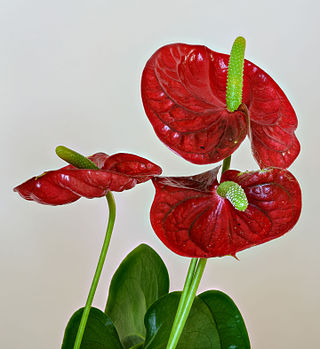
Anthurium is a genus of about 1,000 species of flowering plants, the largest genus of the arum family, Araceae. General common names include anthurium, tailflower, flamingo flower, and laceleaf.
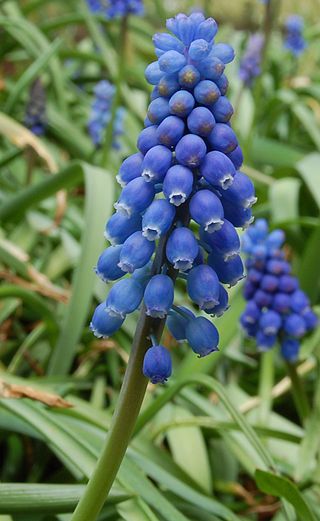
Muscari is a genus of perennial bulbous plants native to Eurasia that produce spikes of dense, most commonly blue, urn-shaped flowers resembling bunches of grapes in the spring. The common name for the genus is grape hyacinth, but they should not be confused with hyacinths. A number of species of Muscari are used as ornamental garden plants.

Claytonia is a genus of flowering plants native to Asia, North America, and Central America. The vitamin-rich leaves can be eaten raw or cooked, and the tubers can be prepared like potatoes.

Nannorrhops ritchiana, the Mazari palm, is the sole species in the genus Nannorrhops in the palm family Arecaceae.

Hemerocallis middendorffii, known as Amur daylily, is a plant species in the subfamily Hemerocallidoideae of the family Asphodelaceae of the order Asparagales. It is native to the Russian Far East, northwest China, Korea, and Japan. It grows in meadows, mountain slopes, open woods, and scrub. It is cultivated in Asia for its edible flowers.

Chaenomeles japonica, called the Japanese quince or Maule's quince, is a species of flowering quince that is native to Japan.

Barleria prionitis is a shrub in the family Acanthaceae, native to Island and Mainland Southeast Asia, China, the Indian Subcontinent, the Arabian Peninsula and northeastern Africa. It is widely spread as an ornamental and weed, occurring in naturalised populations around the world. It used not only as an ornamental but also as a hedge and extensively as a component of folk medicines. As a weed it is regarded as problematic in many areas.
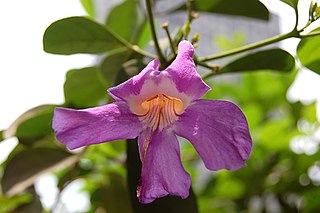
Bignonia magnifica, known as glowvine, is a species in the trumpet-vine family, Bignoniaceae. Originally described in the genus Bignonia in 1879, it was later transferred to the monotypic genus Saritaea as the sole species Saritaea magnifica, but has since been restored to Bignonia. It is native to Panama and northern South America, but has been introduced elsewhere.
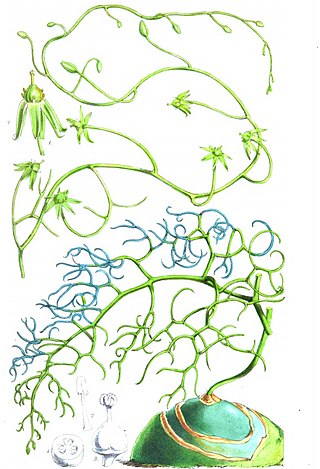
Bowiea is a genus of bulbous, perennial, succulent plants which thrive in dry and desert regions of eastern and southern Africa. It is native to a region stretching from Kenya to Cape Province. The genus contains a single species, Bowiea volubilis.
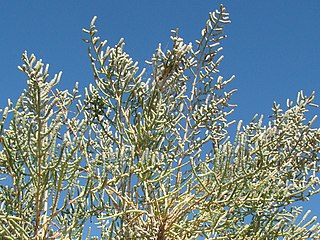
Halostachys is a genus of flowering plants in the plant family Amaranthaceae, containing a single species, Halostachys caspica. The plants are small to medium halophytic shrubs with apparently jointed fleshy stems and scale-like leaves. They are native to Asia and southeastern Europe.
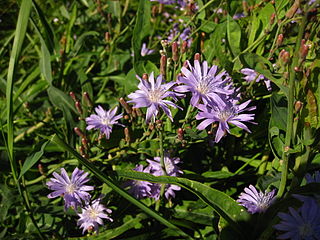
Lactuca tatarica, known as blue lettuce, is a Eurasian flowering plant in the tribe Cichorieae within the family Asteraceae. It is widespread across much of Europe and Asia.

Acanthophyllum is a genus of flowering plants in the family Caryophyllaceae with about 75 species, spread in the Irano-Turanian area.

Catalpa fargesii, the Chinese bean tree, is a species of tree in the family Bignoniaceae, native to China. Growing to about 25 m tall, it is a deciduous tree which produces abundant pink blossom in spring, followed by narrow brown beans-like fruit in the autumn. Some sources place the species as a synonym of Catalpa bungei.

Aubrieta libanotica, common name Lebanese rock cress, is a species of flowering plant in the mustard family Brassicaceae. The genus is named after Claude Aubriet, a French flower painter. A. Libanotica is native to the mountainous ranges of Lebanon and some parts of Syria.
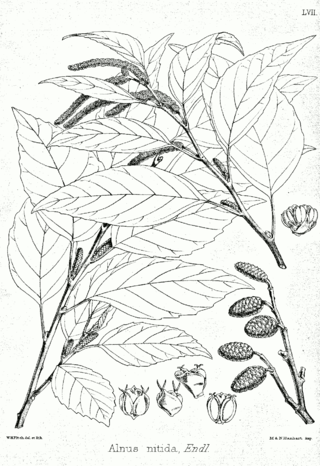
Alnus nitida, the west Himalayan alder, is a species in the genus Alnus, native to Pakistan, the western Himalayas, and Nepal. It is a tree reaching 20 to 25 m, preferring to live along the banks of rivers. It is used locally for timber and firewood, and as a street tree. The bark is used in some places for tanning and dyeing purposes. It grows well in heavy, clay soils and tolerates infertile soils. The leaves are thin, oval to ovate, 3-6 inches long and 2-3 inches wide. Female flowers appear first, followed by male catkinss in September to October, which may be up to 19 cm long. The fruits are woody cones, typically 2.5-3.5 cm long.

Horaninovia is a genus of flowering plants belonging to the family Amaranthaceae. It also belongs to the tribe Salsoleae as well as in the subfamily Salsoloideae.
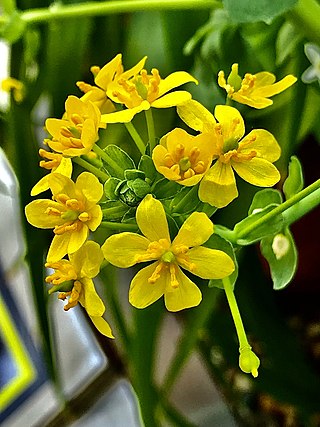
Leontice leontopetalum, commonly known as leontice, lion's foot, lion's turnip, and lion's leaf, is a perennial geophyte having a wide distribution, and growing primarily in semi-desert regions. The name "lion's foot" is derived from the Greek λεοντοπέταλη [= "lioness"] in reference to a fancied resemblance between the shape of the leaves and the pads of a lioness’s paw.




















